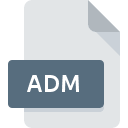.ADM File Extension

Portfolio Admin-Level Access Flag
| Developer | Update Soon |
| Popularity | |
| Category | Misc Files |
| Format | .ADM |
| Cross Platform | Update Soon |
What is an ADM file?
The .ADM file extension is associated with files used primarily in the context of portfolio management systems and administrative tools.
These files often contain metadata or configurations related to administrative access or permissions within a system.
The “ADM” stands for “Admin” or “Administration,” reflecting its role in managing administrative-level settings and permissions.
More Information.
Initially, .ADM files were introduced to streamline the management of administrative settings and permissions in software systems.
Their purpose was to centralize and simplify the configuration of administrative privileges, which was particularly useful in large-scale enterprise environments.
The initial purpose of .ADM files was to enable system administrators to define and manage access levels, permissions, and other critical settings from a single location.
This facilitated better control over who could access or modify certain parts of the system, enhancing security and operational efficiency.
Origin Of This File.
The .ADM file format’s origin lies in the need for managing administrative configurations in various software systems.
Historically, these files emerged with the rise of complex software solutions that required structured methods for controlling access and permissions.
The .ADM file extension became prevalent in environments where administrators needed to handle large amounts of configuration data in a systematic way.
File Structure Technical Specification.
The structure and technical specifications of .ADM files can vary depending on the software or system they are associated with.
A common characteristic is their use of a text-based format for storing configuration data. Here are some typical elements of .ADM file structure:
- Header Information: This section often includes metadata about the file, such as its version and the software it is intended for.
- Configuration Settings: These are the core of the .ADM file, containing various parameters related to administrative access and permissions. This might include user roles, access levels, and specific privileges assigned to different users or groups.
- Administrative Rules: This section outlines rules and conditions under which specific settings apply. These rules help in determining how the permissions and access levels are enforced within the system.
- Comments and Documentation: Many .ADM files include comments or documentation to help administrators understand the configuration settings and their implications. This section is particularly useful for maintaining and troubleshooting the file.
In terms of technical specifications, .ADM files are typically plain text files. They use a structured format to define various settings, which can be read and interpreted by the software or system they are associated with. This format makes it relatively easy for administrators to edit and manage the files using standard text editors.
How to Convert the File?
Converting .ADM files to other formats is generally not straightforward due to their specific role in managing administrative settings. If conversion is necessary, it usually involves:
- Manual Conversion: Administrators may manually extract the relevant configuration data from the .ADM file and input it into the new system or format. This process can be time-consuming and requires a thorough understanding of both the source and target formats.
- Use of Specialized Tools: Some software tools might offer functionality to convert or export .ADM file settings into other formats, such as XML or JSON, which can be more compatible with different systems. However, the availability of such tools depends on the specific software and its capabilities.
- Custom Scripts: In some cases, custom scripts or programs can be developed to automate the conversion process. These scripts can parse the .ADM file, extract the necessary information, and convert it into the desired format.
Advantages And Disadvantages.
Advantages:
- Centralized Management: .ADM files allow for centralized management of administrative settings, making it easier to handle permissions and configurations in large systems.
- Text-Based Format: The plain text format of .ADM files makes them easy to edit and review. Administrators can use basic text editors to make changes, ensuring flexibility and ease of use.
- Documentation: Many .ADM files include comments and documentation, which help administrators understand and manage the settings effectively.
- Customizability: .ADM files can be customized to fit the specific needs of the organization, allowing for tailored management of administrative access and permissions.
Disadvantages:
- Complexity: In large and complex systems, managing .ADM files can become challenging due to the sheer volume of settings and configurations.
- Risk of Misconfiguration: Incorrect modifications to .ADM files can lead to misconfigurations, potentially affecting system security and functionality.
- Lack of Standardization: Different software systems may use different formats or conventions for .ADM files, leading to potential compatibility issues.
- Limited to Specific Systems: .ADM files are often designed for specific software or systems, which means they may not be universally applicable or useful across different platforms.
How to Open ADM?
Open In Windows
- Text Editors: Since .ADM files are typically plain text, you can open them with any standard text editor such as Notepad or Notepad++. Simply right-click the file, select “Open with,” and choose your preferred text editor.
- Administrative Tools: In some cases, .ADM files are used with administrative tools or management consoles within Windows. You can load the .ADM file directly into these tools to manage settings.
Open In Linux
- Text Editors: Linux users can open .ADM files using text editors such as Gedit, Nano, or Vim. Open a terminal and use commands like
gedit filename.admornano filename.admto view and edit the file. - Command-Line Tools: For more advanced users, command-line tools like
catorlesscan be used to view the contents of .ADM files.
Open In MAC
- Text Editors: On macOS, you can use text editors like TextEdit or Sublime Text to open and edit .ADM files. Right-click the file, choose “Open With,” and select your text editor.
- Custom Applications: If the .ADM file is associated with a specific application, you might need to use that application to open and manage the file.











